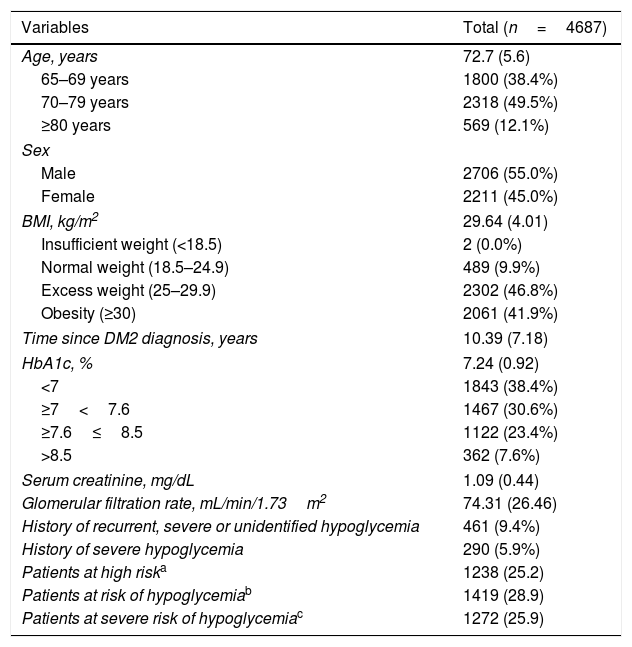Elderly patients with type 2 diabetes represent a growing and heterogeneous group of subjects where treatment targets and antihyperglycemic drugs prescriptions should be tailored according to coexisting illnesses, functional and social domains.
MethodsWe carried-out a national cross-sectional study (from February 2014 to December 2014) to assess prescription patterns and treatment inadequacy in patients with type 2 diabetes older than 65 years with at least 6 months of treatment with antihyperglycemic drugs.
ResultsWe included a total of 4917 patients cared by 2100 family physicians and 450 specialists. Diabetes prescriptions were monotherapy (21.2%), dual therapy (58.1%) and triple therapy (20.6%). The most common prescription patterns were metformin in monotherapy (66.5%), metformin plus DPP4 inhibitors in dual therapy (77.3%) and, in triple therapy, oral drugs (45.5%) and oral drugs plus insulin (45.8%). A total of 1272 (25.9%) patients were at risk of serious hypoglycemia, 643 of them due to treatment with secretagogues (25%) or treatment with human insulin types (25.6%).
ConclusionsElderly patients with type 2 diabetes often receive antihyperglycemic therapy with higher risk of hypoglycemia. Substitution of secretagogues and human insulin therapy for safer medication could significantly reduce the adverse effects of diabetes treatment in this population.
Los pacientes ancianos con diabetes tipo 2 constituyen un grupo heterogéneo y creciente de sujetos en el que los objetivos terapéuticos y las prescripciones de los fármacos antihiperglucemiantes deben adaptarse a las enfermedades coexistentes y a su situación funcional y social.
MétodosRealizamos un estudio transversal (desde febrero de 2014 a diciembre de 2014) para evaluar los patrones de prescripción y la inadecuación del tratamiento en pacientes con diabetes tipo 2 mayores de 65 años con al menos 6 meses de tratamiento con fármacos antihiperglucemiantes.
ResultadosIncluimos un total de 4.917 pacientes atendidos por 2.100 médicos de familia y 450 especialistas. Las prescripciones para la diabetes fueron monoterapia (21,2%), terapia dual (58,1%) y terapia triple (20,6%). Los patrones de prescripción más frecuentes fueron el de metformina en monoterapia (66,5%), metformina más inhibidores de la DPP-4 en terapia dual (77,3%) y, en terapia triple, fármacos orales (45,5%) y fármacos orales más insulina (45,8%). Un total de 1.272 (25,9%) pacientes presentaban riesgo de hipoglucemia grave, de los cuales 643 (50,6%) estaban en tratamiento con secretagogos (25%) o con insulina humana (25,6%).
ConclusionesLos pacientes ancianos con diabetes tipo 2 reciben a menudo terapia antihiperglucemiante que comporta un alto riesgo de hipoglucemia. La sustitución de los secretagogos y de la terapia con insulina humana por una medicación más segura reduciría considerablemente los efectos secundarios del tratamiento de la diabetes en esta población.
Article
Diríjase desde aquí a la web de la >>>FESEMI<<< e inicie sesión mediante el formulario que se encuentra en la barra superior, pulsando sobre el candado.

Una vez autentificado, en la misma web de FESEMI, en el menú superior, elija la opción deseada.

>>>FESEMI<<<










